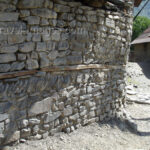Stone masonry is a traditional form of construction that has been practiced for centuries in regions where stone is locally available. Stone masonry has been used for the construction of some of the most important monuments and structures around the world. Buildings of this type range from cultural and historical landmarks, often built by highly skilled stonemasons, to simple dwellings built by their owners in developing countries where stone is an affordable and cost-effective building material for housing construction. Stone masonry buildings can be found in many earthquake prone regions and countries including Mediterranean Europe, North Africa, the Middle East, and Southeast Asia. The World Housing Encyclopedia currently contains 15 reports describing stone masonry housing construction practices in Algeria, Greece, India, Iran, Italy, Nepal, Pakistan, Palestinian Territories, Slovenia, and Switzerland.
Houses of this construction type are found in urban and rural areas around the world. There are broad variations in construction materials and technology, shape, and the number of stories. Houses in rural areas are generally smaller in size and have smaller sized openings since they are typically used by a single family. Multi-family residential buildings in urban areas are often of mixed use – with a commercial ground floor and a residential area above. Houses in rural areas and suburbs of urban centers are built as detached structures, while housing units in urban centers often share a common wall.
Stone Masonry Test in Peshawar, Pakistan
VIDEO: Shake table testing performed at NESDE in Lisbon, Portuga
Further introductory reading: “Stone Masonry Construction” (Marjana Lutman)
Download: ENGLISH [0.3MB]
Contents:
-Background and history
-Performance in previous earthquakes
-Seismic strengthening for new and old constructions

